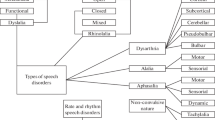Abstract
A probabilistic stochastic model deals with the real life applications of networks such as wireless communication, signals, speech synthesis, biomedical data in terms of blood pressure, ECG, EEG and temperature of a human being etc. An important class of stochastic process is Markov process which possess the past forgetting property, that is the result arises from each incident rely on the present but not on the past. This Markov property enables reasoning and computation with the model that would be otherwise intractable. In this paper the speech disorder developed by the Febrile infection-related epilepsy syndrome (FIRES) disease whose symptoms are discussed using Markov chain modeling as a new technique and its properties using a pictorial representation to enable the identification of an effective speech disorder therapy.





Similar content being viewed by others
References
Anitha Florence Vinola, F., & Padma, G. (2015). A qualitative analysis on the risk determination and national security. International Journal of Applied Engineering Research, 10(2), 5227–5233.
Anumanchipalli, G. K., Chartier, J., & Chang, E. F. (2019). Speech synthesis from neural decoding of spoken sentences. Nature, 568(7753), 493–498.
Bhati, D., Sharma, M., Pachori, R. B., & Gadre, V. M. (2017). Timefrequency localized three-band biorthogonal wavelet filter bank using semidefinite relaxation and nonlinear least squares with epileptic seizure EEG signal classification. Digital Signal Processing, 62, 259–273.
Bryan, J. D., & Levinson, S. E. (2015). Autoregressive hidden Markov model and the speech signal. Procedia Computer Science, 61, 328–333.
Busatlic, B., Dogru, N., Lera, I., & Sukic, E. (2017). Smart homes with voice activated systems for disabled people. TEM Journal, 6(1), 103.
Chang-xing, L., & Su-mei, Z. (2009). Probe into the teaching of probability theory and stochastic process. In 2009 International Conference on Computational Intelligence and Software Engineering
Cinlar, E. (2013). Introduction to stochastic processes. North Chelmsford: Courier Corporation.
Hsu, H. P. (2010). Schaum’s outline of theory and problems of probability, random variables, and random processes. New York: McGraw-Hill.
Jean Shilpa, V., & Jawahar, P. K. (2019). Advanced optimization by profiling of acoustics software applications for interoperability in HCF systems. Journal of Green Engineering, 9(3), 462–474.
Kachapova, F. (2013). Representing Markov chains with transition diagrams. Journal of Mathematics and Statistics, 9(3), 149–154.
Kayte, S., Mundada, M., & Gujrathi, J. (2015). Hidden Markov model based speech synthesis: A review. International Journal of Computer Applications, 130(3), 35–39.
Kollmann, A., Kastner, P., & Schreier, G. (2007). Utilizing mobile phones as patient terminal in managing chronic diseases. In L. Al-Hakim (Ed.), Web mobile-based applications for healthcare management (pp. 227–257). Pennsylvania: IGI Global.
Margreat, L., Anitha Florence Vinola, F., Pathinathan, T., & Padma, G. (2015). Cause-effect petri nets (CEPN) to analyze the major factors that cause stress to school teachers. Global Journal of Pure and Applied Mathematics, 11(2), 725–731.
Masino, S. A., Kawamura, M, Jr., Wasser, C. A., Pomeroy, L. T., & Ruskin, D. N. (2009). Adenosine, ketogenic diet and epilepsy: the emerging therapeutic relationship between metabolism and brain activity. Current Neuropharmacology, 7(3), 257–268.
Matamalas, J. T., Arenas, A., & Gmez, S. (2018). Effective approach to epidemic containment using link equations in complex networks. Science Advances, 4(12), eaau4212.
Mei, Z., Zhao, X., Chen, H., & Chen, W. (2018). Bio-signal complexity analysis in epileptic seizure monitoring: A topic review. Sensors, 18(6), 1720.
Padma, G. (2014a). An analysis on the applications of Markov random fields in error correcting codes of nano memory cells. In 2014 IEEE International Conference on Computational Intelligence and Computing Research, IEEE (pp. 1–4).
Padma, G. (2014b). A probabilistic approach for the fatigue growth rate in walls. International Journal of Applied Engineering Research, 9(23), 21721–21729.
Padma, G., & Vijayalakshmi, C. (2008). An analysis and design of a hidden Markov model based on probabilistic approach for evaluating risk propagation. Proceedings of International conference on Emerging Scenarios in Space Technology and Applications (pp. 621–624). Sathyabama University, Chennai.
Padma, G., & Vijayalakshmi, C. (2012a). Implementation of a probabilistic model for the effective production management. European Journal of Scientific Research, 85(3), 373–381.
Padma, G., & Vijayalakshmi, C. (2012b). A probabilistic approach for the analysis of free- energy distribution in proteins. BTAIJ, 6(1), 16–21.
Reni Sagayaraj, M., Michael Raj, A., & Sathyavani, G. (2015). A study on Markov chain with transition diagram. International Journal of Technical Research and Applications, 3(2), 123–125.
Revuz, D. (2008). Markov chains. Amsterdam: Elsevier.
Santhosh, J., & Raji, N. (2015). Cardiac abnormality detection from ECG using AHMM. International Journal of Innovative Research in Computer and Communication Engineering, 3, 7658–7664.
Shannon, M., & Byrne, W. (2009). A formulation of the autoregressive HMM for speech synthesis. Cambridge: Cambridge University Press.
Sherlock, C., Xifara, T., Telfer, S., & Begon, M. (2013). A coupled hidden Markov model for disease interactions. Journal of the Royal Statistical Society: Series C (Applied Statistics), 62(4), 609–627.
Taylor, P. (2009). Text-to-speech synthesis. Cambridge: Cambridge University Press.
Thurman, D. J., Begley, C. E., Carpio, A., Helmers, S., Hesdorffer, D. C., Mu, J., et al. (2018). The primary prevention of epilepsy: A report of the Prevention Task Force of the International League Against Epilepsy. Epilepsia, 59(5), 905–914.
Vaithyasubramanian, S., & Christy, A. (2014). An analysis on 1-step transition probability matrix and 2-step transition probability matrix of markov passwords. International Journal of Applied Engineering research, 9(20), 7745–7753.
Vaithyasubramanian, S., & Christy, A. (2015). A scheme to create secured random password using markov chain. In D. Dasgupta & Z. Michalewicz (Eds.), Artificial intelligence and evolutionary algorithms in engineering systems (pp. 809–814). New Delhi: Springer.
Vaithyasubramanian, S., Christy, A., & Saravanan, D. (2014). An analysis of Markov password against brute force attack for effective web applications. Applied Mathematical Sciences, 8(117), 5823–5830.
Author information
Authors and Affiliations
Corresponding author
Additional information
Publisher's Note
Springer Nature remains neutral with regard to jurisdictional claims in published maps and institutional affiliations.
Rights and permissions
About this article
Cite this article
Anitha Florence Vinola, F., Padma, G. A probabilistic stochastic model for analysis on the epileptic syndrome using speech synthesis and state space representation. Int J Speech Technol 23, 355–360 (2020). https://doi.org/10.1007/s10772-020-09702-1
Received:
Accepted:
Published:
Issue Date:
DOI: https://doi.org/10.1007/s10772-020-09702-1




